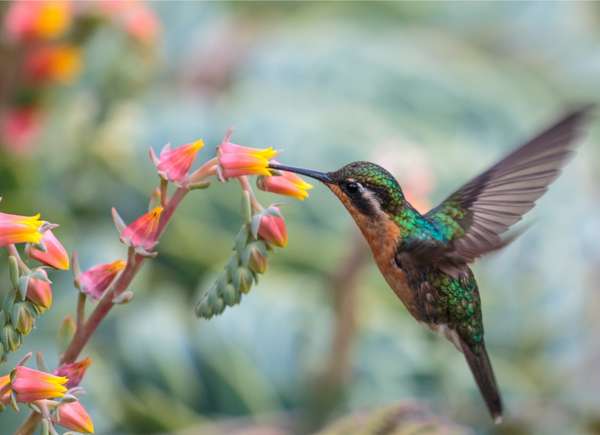

We may earn revenue from the products available on this page and participate in affiliate programs. Learn More ›
Although more than 300 known species of hummingbird grace gardens around the world, only about a dozen species routinely migrate through North America, and even fewer remain year-round in the warmest areas of the West. These amazingly tiny birds—the smallest bird in the world is the bee hummingbird, which weighs less than an ounce—mostly prefer the warmth of the tropics in Central and South America.
These voracious flying gems have the highest metabolic rate of any animal on earth and spend most of their waking hours in search of the sugary nectar that provides most of their energy. A single hummingbird might visit as many as 2,000 flowers in one day, lapping up nectar with its extremely long tongue.
How to Choose Hummingbird-Friendly Flowers
If your region is visited by hummingbirds during the spring and summer months—visiting hummers are typically the ruby-throated hummingbird in the East, and Costa’s, Anna’s, Allen’s, black-chinned, and rufous hummingbirds in the West—you can encourage them to stop by your garden on their travels by growing some of the many plants that attract hummingbirds.
What kind of flowers do hummingbirds like? If you want hummingbirds to linger on your property, take note: They are particularly attracted to brightly colored flowers—especially red—with a tubular shape, and find yellow and white flowers less enticing. These preferences mean that when you enliven your garden with plants that produce flowers for hummingbirds, you’ll also be adding vibrant, cheerful color to your landscape.
The 30 Best Flowers for Hummingbirds
Hummingbirds must ingest significant quantities of sugary plant nectar in order to generate the energy needed to keep their wings beating at 70 flaps per second. The birds have learned that very colorful flowers, like those listed here, tend to have a good nectar supply.
As you peruse this list, keep in mind that the USDA released a new, improved Plant Hardiness Zone Map in 2023. You might want to check the map to make sure your region hasn’t shifted zones before you go on a plant-buying spree.
1. Lantana (Lantana camara)
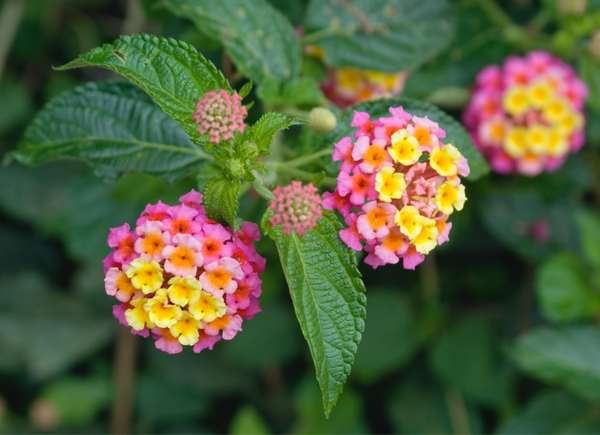
Exuberant flowers—the individual blooms are tiny, but they burst forth in tight clusters—place lantana high among the plants that attract butterflies and hummingbirds. Some lantana varieties display just one color of flower per cluster, but most feature clusters of several colors, such as hot pink and yellow or orange and red.
Grow lantana in a sunny spot, and let the soil dry slightly between waterings. In areas with winter temperatures below freezing, lantana is usually considered an annual, although it can sometimes come back in spring, but it thrives year-round in the warmest climates.
Blooms: Late spring through frost where grown as an annual; nearly year-round in warmer regions
Colors/Varieties: Pink/yellow/orange, red, purple, and white
USDA Growing Zones: Annual in Zones 1 to 8; perennial in Zones 9 to 11
Mature Size: Some varieties grow to 4 or 5 feet tall and a couple of feet wide; others have a spreading habit, growing to 4 feet wide but only 2 feet tall.
Special Concerns: Lantana is drought-tolerant but will produce more blooms if watered regularly.
2. Penstemon (Penstemon species)
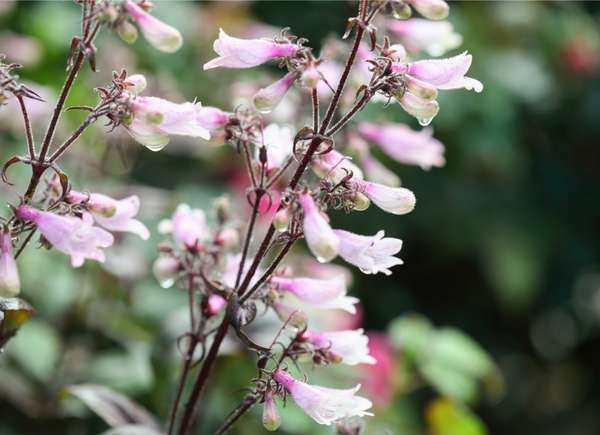
A large family of North American natives, penstemon comes in many colors and heights, but all produce tubular blooms that hummingbirds love, especially if you choose purple, red, or pink varieties. Two particularly good varieties are firecracker (Penstemon eatonii) and Parry’s penstemon (Penstemon parryi).
Penstemon is a fairly easy perennial to grow in a sunny location with excellent soil drainage. Don’t fertilize often; penstemon prefers slightly poor soil.
Blooms: Early to mid-summer
Colors/Varieties: Blue, purple, pink, white, and red
USDA Growing Zones: Varies, depending on the species, of which there are 250
Mature Size: Depending on variety, 1 to 4 feet tall and 2 feet wide
Special Concerns: With so many varieties to choose from, be sure to select types that are known to do well in your area.
3. Trumpet Vine (Campsis radicans)
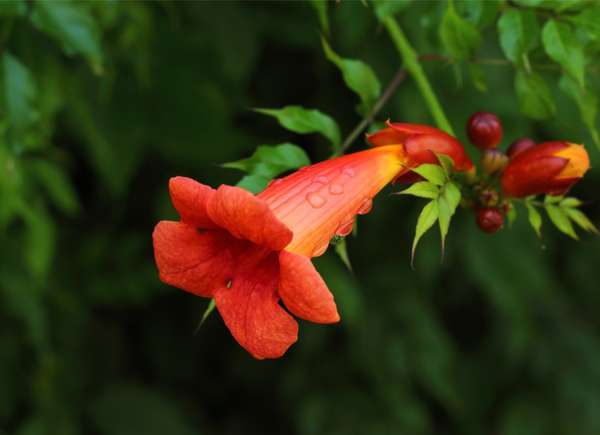
Also called trumpet creeper, this glorious vine explodes in summer through fall with bright orange flowers that hummers simply cannot resist. A native to eastern North America, trumpet vine grows quickly and vigorously, and needs a strong arbor, trellis, or fence for support.
Cut back as needed to keep it under control, and don’t water or fertilize too frequently; this hardy vine prefers slightly poor, dry soil.
Blooms: Throughout summer and fall
Colors/Varieties: Yellow, orange, and red
USDA Growing Zones: Zones 4 to 11
Mature Size: Runners can reach 30 feet long
Special Concerns: Aggressive trumpet vine can become invasive. The plant’s sap can cause skin irritation.
4. Petunia (Petunia species)
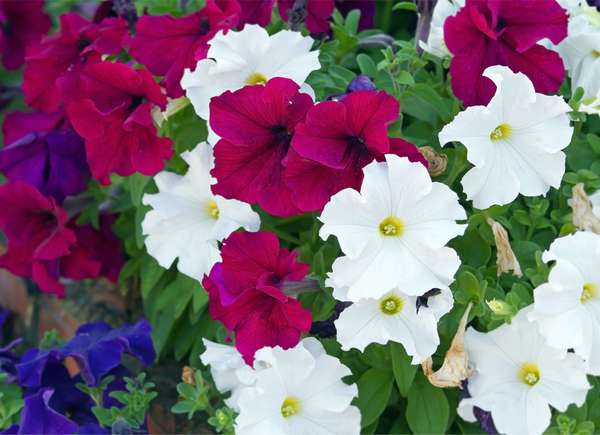
Do hummingbirds like petunias? Absolutely, and they like native varieties best because those tend to have more nectar than some of the nonnative types. One of the most popular spring-through-summer annuals, petunias are available in just about every color of the rainbow, as well as bicolor varieties.
Petunias are easy to grow in hanging baskets or other containers, so they’re high on the list of the best potted plants that attract hummingbirds. They also make a beautiful garden border or a nice addition to a raised bed. Just give petunias plenty of sun, keep the soil moist but not soggy, and feed once or twice during their growing season. Hummers are especially fond of red, purple, and pink varieties.
Blooms: Spring through fall
Colors/Varieties: White, yellow, pink, purple, red, and blue
USDA Growing Zones: Annual in Zones 1 to 8; perennial in Zones 9 to 11
Mature Size: 6 to 18 inches tall; 18 inches to 4 feet wide
Special Concerns: Spreading types require more irrigation than clumping types. Remove faded flowers from plants (known as deadheading) to promote vigorous blooming.
5. Salvia (Salvia species)

Salvia is a large genus of plants in the mint family. The plants produce tall spikes of clustered flowers and have lance-shaped leaves that give off a distinctive fragrance when cut or crushed. While butterflies, bees, and hummingbirds flock to just about every variety of salvia, you can count on hummers visiting Salvia microphylla ‘Hot Lips,’ which has two-toned red and white blooms, and Salvia greggii, often called autumn sage.
This North American native produces red, purple, pink, or white flowers, summer through fall. All salvias prefer sunny locations and are moderately drought resistant, but they need regular watering in times of extreme heat or drought.
Blooms: Summer through fall
Colors/Varieties: Blue, red, purple, orange, pink, yellow, white, green, and brown, with some multicolor varieties
USDA Growing Zones: Varies by variety, but some are hardy as far north as Zone 5.
Mature Size: 1 to 4 feet tall and wide, depending on type
Special Concerns: Prune in late winter and cut off dying flowers during the bloom season.
6. Lupine (Lupinus x hybrid)
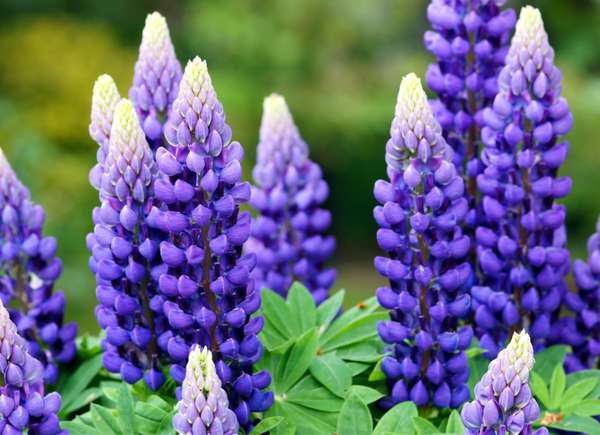
Most lupines sold in garden centers are hybrids of various wild lupines. These North American natives feature a wide range of colors and sizes, but all produce spikes of tubular flowers that attract all types of pollinators, including hummingbirds.
Plant lupine in a sunny location with good drainage and slightly acidic soil, and don’t fertilize it often. While lupine is a tender perennial, in many areas, especially in hot climates, it is treated as an annual.
Blooms: Spring and summer
Colors/Varieties: White, pink, red, yellow, blue, purple, and bicolor
USDA Growing Zones: Zones 4 to 10b
Mature Size: 10 to 24 inches tall and wide
Special Concerns: All parts of the plant are toxic.
7. Columbine (Aquilegia species)
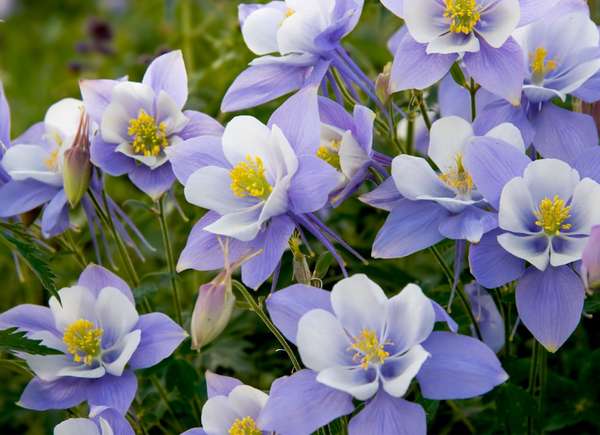
Although columbine appears delicate, this perennial beauty is actually fairly easy to grow in areas that aren’t too hot during its summer bloom time. While there are many cultivars and hybrids of columbine, all of which attract hummingbirds, one that is especially appealing is red columbine (Aquilegia canadensis).
Plant columbine in a partly shady spot and keep it moist but not soggy. Cutting spent flowers encourages repeat blooms. Columbine struggles in extremely hot weather.
Blooms: Spring to summer
Colors/Varieties: Red, orange, yellow, blue, purple, pink, and white
USDA Growing Zones: Zones 3 to 9
Mature size: 2 to 3 feet tall; 1 to 2 feet wide
Special Concerns: Short-lived perennial that reseeds
8. Cardinal Flower (Lobelia cardinalis)
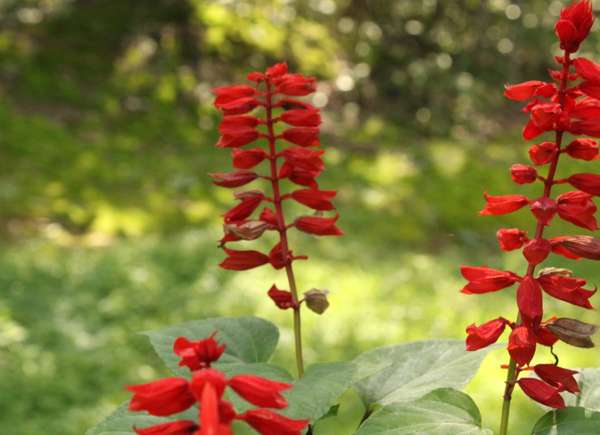
Hummingbirds find the bright red tubular blooms of cardinal flower irresistible, and these tiny fliers are the primary pollinator of this North American native. While technically a perennial, cardinal flower does not live long, but it does reseed prolifically.
This woodland flower likes some shade and does best in moist soil; covering the soil with mulch helps the plant thrive. As a bonus, deer rarely bother this garden showstopper.
Blooms: Summer to early fall
Colors/Varieties: Red, pink, white, blue, and purple
USDA Growing Zones: Zones 3 to 9
Mature size: 4 to 5 feet tall; 1 to 2 feet wide
Special Concerns: Must be divided every 3 years to survive
9. Hosta (Hosta species)
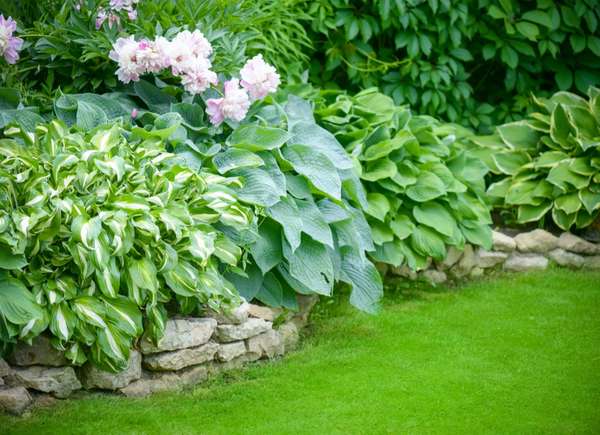
A mainstay of the shade garden, hosta varieties appear in an excellent assortment at most nurseries. And while most people plant hostas for their foliage, thanks to the many leaf colors and patterns available, it does bloom during the summer, mostly in small white or purple flowers.
Hummingbirds love hosta’s tubular blooms, which add beautiful contrast to the plant’s greenery. Keep hostas mulched and water them regularly. Watch out for snails, which love to nibble the leaves.
Blooms: Summer
Colors/Varieties: White, lavender, and pink
USDA Growing Zones: Zones 3 to 9
Mature Size: 12 to 15 inches tall; 10 to 24 inches wide
Special Concerns: Deer enjoy snacking on hosta.
10. Cigar Plant (Cuphea ignea)
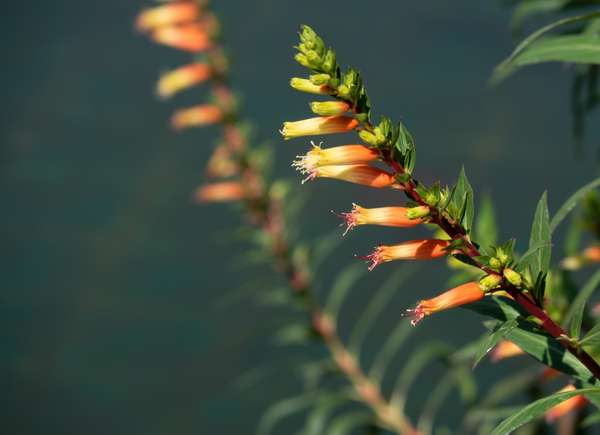
Also called firecracker plant, the cigar plant has long, thin bright orange flowers that hummingbirds love. A native to Mexico, the cigar plant blooms exuberantly through the spring and summer.
In cold climates, cigar plant generally grows as an annual, but it will thrive year-round in warmer areas. Water the plant regularly, pinch it back occasionally so it doesn’t get leggy, and grow it in full sun to part shade.
Blooms: Spring through fall
Colors/Varieties: Red
USDA Growing Zones: Zones 9b to 12
Mature Size: 2 to 3 feet tall; 3 to 5 feet wide
Special Concerns: Cigar plant can get leggy; pinch back stem tips to encourage bushiness.
11. Flowering Tobacco (Nicotiana alata)
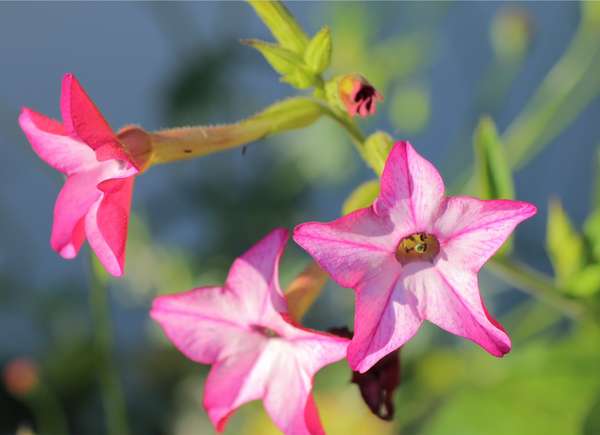
Most varieties of flowering tobacco grown in the garden are annuals, although some can survive year-round in climates with mild winters. These delicate beauties bloom summer through fall, with the flowers opening during the evening to release a wonderful fragrance.
Hummingbirds and other pollinators love the white, red, pink, or even green blossoms. Flowering tobacco does best in rich soil that drains well and prefers not to be too hot or too cold. Deadhead flowers to encourage a longer bloom time.
Blooms: Summer to fall
Colors/Varieties: Yellow-green, white, pink, red, and yellow
USDA Growing Zones: Zones 10 to 11b
Mature Size: 3 to 5 feet tall; 1 to 2 feet wide
Special Concerns: Toxic to dogs, cats, and horses
12. Bee Balm (Monarda species)
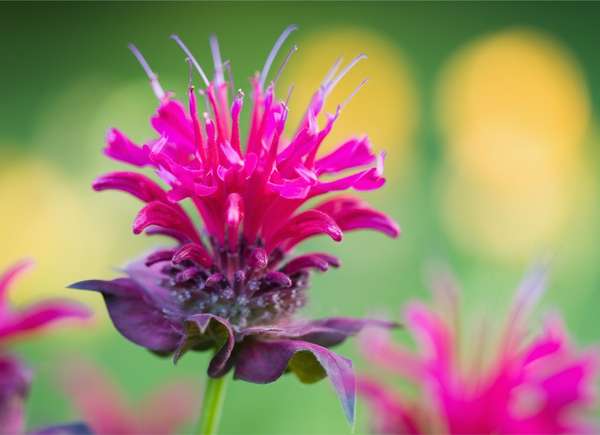
Another native to North America, bee balm, a member of the mint family, features red, pink, purple, or white flowers that attract bees, butterflies, and hummingbirds like a magnet. A perennial, bee balm does best when grown in full sun, although it will tolerate some shade.
Bee balm likes fairly moist soil and requires good air circulation to ward off its archnemesis, downy mildew. Deadhead spent blooms to keep flowers coming all summer long.
Blooms: Summer to fall
Colors/Varieties: Red, pink, purple, and white
USDA Growing Zones: Zones 4a to 9b
Mature Size: 2 to 4 feet tall; 1½ to 3 feet wide
Special Concerns: Mildew is common after flowering.
13. Zinnia (Zinnia violacea)
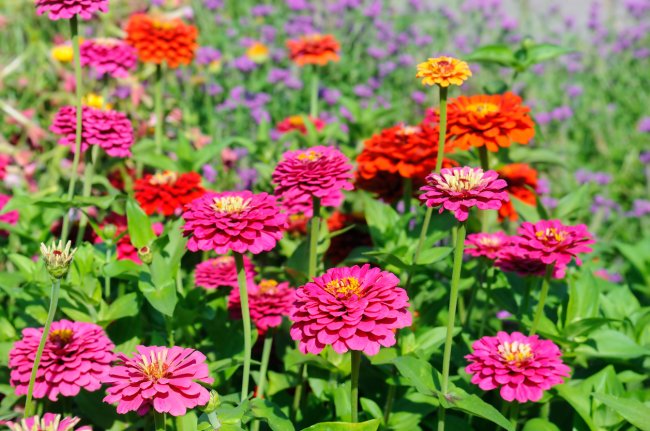
An easy flower to grow, this heavy bloomer is a cutting garden staple because of its bright single flower head on erect stems. The many varieties of zinnia to choose from include single, semi-double, and double-flowered; different shapes, such as beehive, button, and cactus; and even different heights.
These deer-resistant plants grow quickly from seed in full sun and make excellent borders. Ensure plants have good air circulation.
Blooms: Late spring through first frost
Colors/Varieties: Pink, purple, yellow, orange, lavender, white, red, and green
USDA Growing Zones: Annual in Zones 2 to 8; perennial in Zones 9 to 11
Mature Size: 8 inches to 4 feet tall
Special Concerns: Susceptible to powdery mildew.
14. Annual Geranium (Pelargonium species)
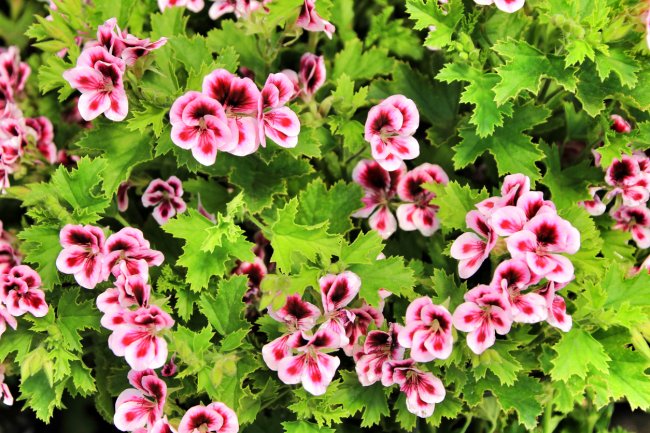
If you’re looking for hanging plants that attract hummingbirds, consider geranium—colorful, hardy plants that enjoy full sun and plenty of water, although not wet foliage. Deer-resistant geraniums do well as full-sun container plants or in flower beds.
Geraniums are available in several shades, and they also come in various forms, such as ivy, scented, fancy-leaf with variegated leaves, and the large Martha Washington ruffled varieties. Be sure to deadhead spent flowers for more blooms.
Blooms: Spring through fall
Colors/Varieties: Red, burgundy, lavender, pink, salmon, orange, white, and bicolor
USDA Growing Zones: Annual in Zones 1 to 9; perennial in Zones 10 to 11
Mature Size: 1 to 3 feet tall and wide
Special Concerns: Can be bothered by caterpillars, whiteflies, and aphids.
15. Bleeding Heart (Lamprocapnos spectabilis)
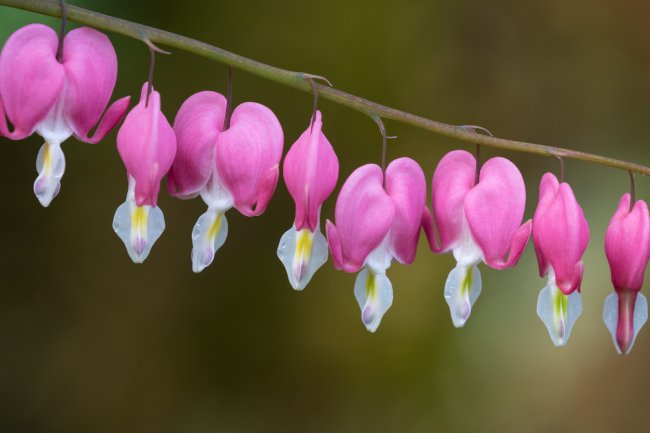
Brighten up a shady or semi-shady spot with this delicate spring bloomer whose arching branches of heart-shaped flowers seem to drip out their insides in sorrow. This herbaceous perennial requires little care, dying back to the ground in late fall and returning in the spring.
Featuring attractive, serrated leaves, bleeding heart prefers well-drained, moist, and nutrient-rich soil. The noninvasive plant is deer-resistant.
Blooms: Spring
Colors/Varieties: Pink, white, and red
USDA Growing Zones: Zones 2 to 9
Mature Size: 3 feet tall and 4 feet wide
Special Concerns: All parts of the plant are toxic.
16. Lilac (Syringa vulgaris)
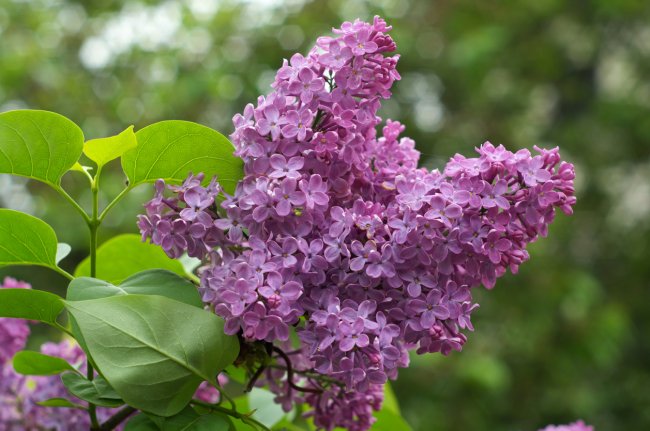
Prized for its aromatic clusters of tiny purple or white flowers, this deciduous shrub can grow 8 to 16 feet tall. Its grayish bark is matched by gray-green or blue-green leaves. While some lilacs are small enough to grow near a home or in a garden bed, most varieties are better used as focal plants or grown in a group to form a border.
Grow lilacs in rich, moist soil that drains well, and fertilize annually. Careful pruning will encourage profuse blooming year after year. Cut off the flowers immediately after they have faded in late spring or early summer. Because lilacs set the buds in summer for the next spring’s display, don’t put off pruning too long.
Blooms: Spring
Colors/Varieties: Light purple, dark purple, and white
USDA Growing Zones: Zones 3a to 7a
Mature Size: 12 to 16 feet tall; 8 to 12 feet wide
Special Concerns: Lilac shrubs may take 3 or 4 years to fully establish themselves and start blooming.
17. Fuschia (Fuchsia species)
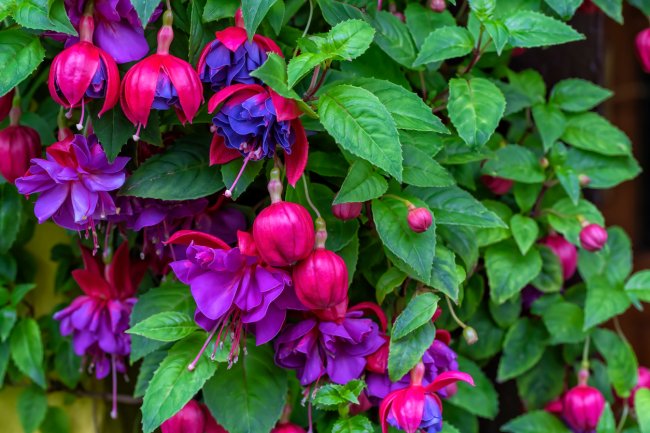
Fuchsia, named in honor of 16th-century physician and botanist Leonhart Fuchs, is a beautiful, colorful hummer magnet. With exotic single or double flowers that dangle from elongated stems, fuchsia is an excellent candidate for hanging baskets.
Fuchsia prefer rich, moist soil and are partial to full shade as well as protection from the wind, which can easily damage their delicate blooms. Fuchsia can be overwintered indoors in a cool location (45 to 50 degrees Fahrenheit), such as a garage.
Blooms: Spring through fall
Colors/Varieties: Red, pink, white, violet, and purple
USDA Growing Zones: Annual in most zones; perennial in Zones 10 to 11
Mature Size: 2 to 10 feet tall and wide, depending on variety
Special Concerns: Can be troubled by aphids, spider mites, and whiteflies
18. Snapdragon (Antirrhinum majus)
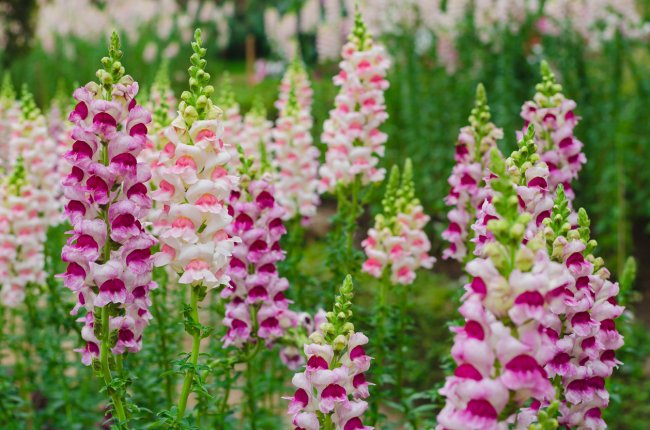
To the delight of children and gardeners, the snapdragon opens its “mouth” when pinched in the right spot—but for hummers, with their needle-like beak and long tongue, no pinching is required to reach the sweet nectar.
Snapdragons prefer moderate to cooler temps. Flowering may slow down in the heat of the summer but will revive with early fall weather. Because the blooms open in stages from the bottom up, bloom time is extended. Available in various sizes, snapdragons can bring height to a garden with their spiky blooms or add interest (and hummingbird food) to a mixed border.
Blooms: Spring through fall
Colors/Varieties: White, yellow, pink, red, orange, peach, purple, and violet
USDA Growing Zones: Zones 7 to 11
Mature Size: 1 to 3½ feet tall; 1 to 1½ feet wide
Special Concerns: Tall varieties may need to be staked.
19. Begonia (Begonia species)
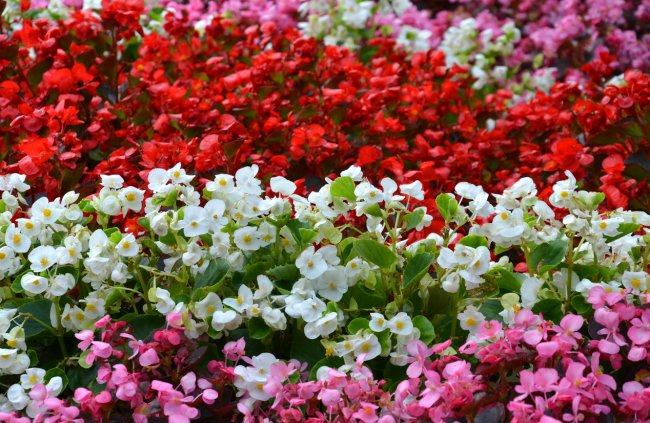
There are more than 2,000 species of begonias, but the common variety planted in most gardens is the wax begonia. This small, tuberous plant prefers partial shade and moist (but not soggy) soil.
Deer-resistant and requiring little to no pruning, begonias are easy to care for and will provide a bounty of single or double shimmery blooms in the right conditions. Foliage can be green or red.
Blooms: Summer
Colors/Varieties: Red, pink, and white
USDA Growing Zones: Hardy in Zones 10 to 11; grown as annual (or indoors) in other zones
Mature Size: 8 inches to 3 feet tall; 6 to 18 inches wide
Special Concerns: Keep an eye out for powdery mildew.
20. Catmint (Nepeta species)
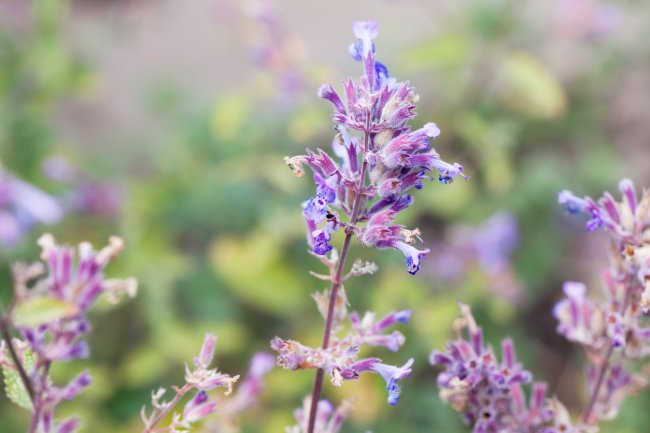
Let the lacy, delicate gray-green foliage of catmint billow along pathways, its fragrance drifting across gardens and lawns. This easy-to-grow perennial herb has few pests or problems. Deer-resistant and fast growing, it thrives on neglect as long as it’s in full sun and well-draining soil.
Whether it sprawls or stands upright, catmint’s spikes of flowers bloom throughout the growing season, producing waves of tiny blossoms on delicate stalks. Catmint can be grown as a mosquito repellent.
Blooms: Late spring, summer
Colors/Varieties: Blue, white, and pink
USDA Growing Zones: Zones 3a to 8b
Mature Size: 18 inches to 3 feet tall and wide
Special Concerns: Most cats are indifferent to catmint—as opposed to its cousin, catnip—but some felines are indeed partial to catmint.
21. Foxglove (Digitalis purpurea)
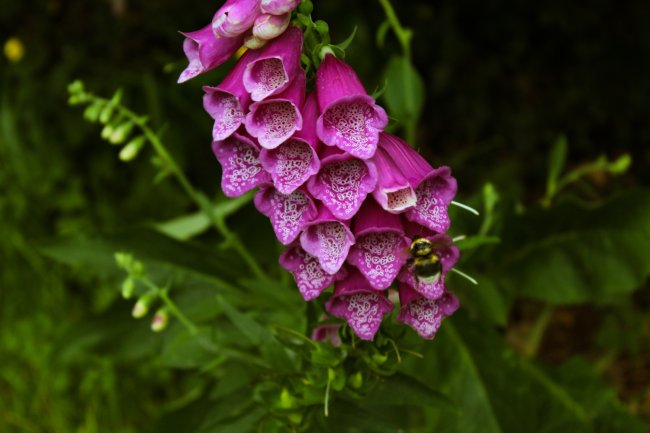
Add some height to your garden with this biennial that grows 2 to 5 feet tall and spills tubular, bell-shaped flowers with spotted throats downward along its leggy stalk. Keep in mind that foxglove blooms only in its second year.
Foxglove prefers moist, fertile, and well-drained soil. It will do well in full sun or partial shade; woodland areas are particularly hospitable. These deer-resistant plants are nice in cottage gardens too.
Blooms: Early summer, or late spring in warmer zones
Colors/Varieties: Pink, purple, red, white, and yellow
USDA Growing Zones: Zones 4 to 10
Mature Size: 3 to 4 feet tall; 1 foot wide
Special Concerns: All parts of digitalis are toxic to animals and humans.
22. Daylilies (Hemerocallis species)
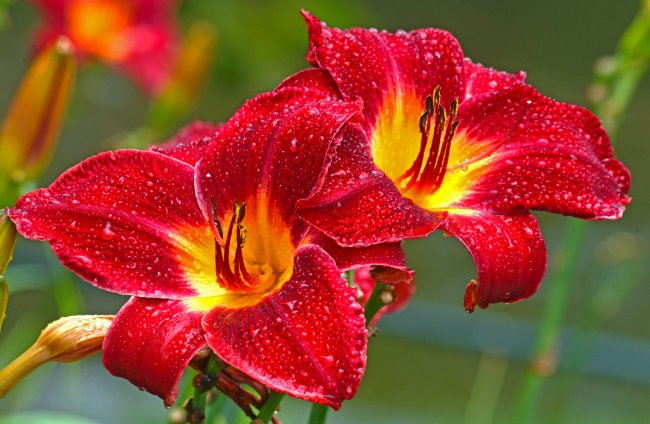
One of the easiest, most forgiving low-maintenance perennials is the daylily. Not fussy about soil or light, drought- and heat-tolerant, disease- and pest-free, this versatile plant works well in a border or on its own.
From grasslike leaves shoot leafless stems (scapes) bearing large, colorful trumpet-shaped flowers that typically last for a day. Hybridizers experiment with new varieties, including spider, ruffled, doubles, and repeat bloomers, so don’t feel confined to just the popular Stella de Oro.
Blooms: Spring to late summer, plus some repeat blooming varieties
Colors/Varieties: Red, orange, yellow, purple, and pink
USDA Growing Zones: Zones 3 to 10
Mature Size: 1 to 4 feet tall; 1 to 3 feet wide
Special Concerns: Subject to leaf streak (yellowing and browning leaves), caused by a fungus.
23. Rhododendron (Rhododendron species)
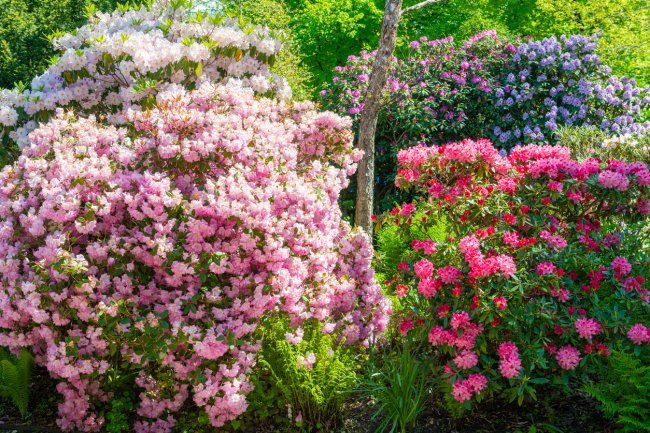
Washington’s state flower is a woody shrub that can grow up to 25 feet wide, offering a virtual buffet for hummingbirds. Rhododendron prefers a sunny location and is fussy about temperature, not wanting to be either too hot or too cold (although some cooler weather is required for bud formation).
Known for their showy clusters of delicate bell-shaped flowers, rhododendrons also feature thick, leathery leaves that stay green late into the year. These large shrubs are often used as hedges.
Blooms: Spring to fall
Colors/Varieties: Pink, purple, red, yellow, and white
USDA Growing Zones: Zones 3 to 9
Mature Size: 5 to 10 feet tall; 5 to 25 feet wide
Special Concerns: Rhododendrons need a fairly acidic soil: pH 4.5 to 5.5.
24. Wisteria (Wisteria species)
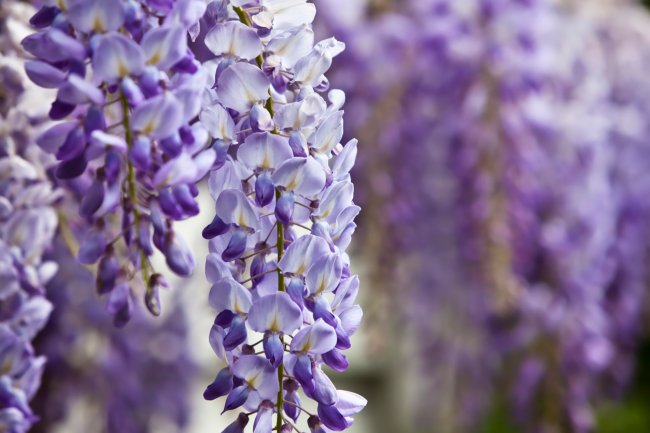
This deciduous, wood-stemmed vine drips fragrant grape-like clusters of lavender flowers from arbors or trellises, creating a romantic garden aesthetic. After blooming, the long-lived, sometimes invasive, vine will require pruning, for it grows quickly and is aggressive and heavy.
In the right conditions, wisteria can destroy porch railings and pergolas alike if not kept in line. Besides, blooms appear only on new growth, so late winter pruning helps produce more flowers for spring hummingbirds. All parts are toxic to pets and people.
Blooms: Spring
Colors/Varieties: Purple, pink, and white
USDA Growing Zones: Zones 4 to 8
Mature Size: Vines can grow 15 to 25 feet
Special Concerns: Their weight and twisting habit can damage structures on which they climb.
25. Hollyhocks (Alcea rosea)
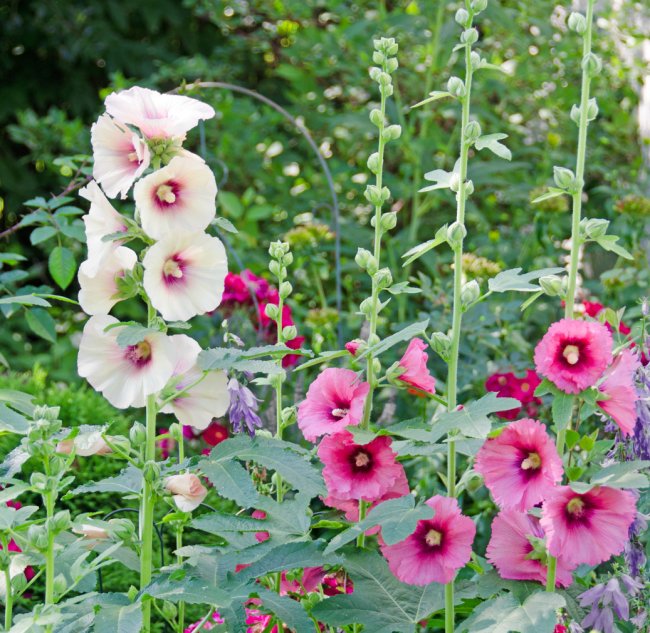
Nothing says summertime cottage garden like the tall, slender hollyhock. The self-seeding perennial or biennial can reach 8 to 9 feet tall, sprouting multipetaled flowers that bloom from the bottom of the stalk up.
They prefer full sun and can grow in a variety of well-draining soil types, but they may require a little support—and protection from the wind—to stay upright. Pollinators prefer the single-flowering varieties.
Blooms: Summer
Colors/Varieties: Lavender, white, pink, red, and yellow
USDA Growing Zones: Zones 2 to 10
Mature Size: 6 to 8 feet tall; 1 to 2 feet wide
Special Concerns: Foliage is susceptible to rust and leaf spot.
26. Honeysuckle (Lonicera species)
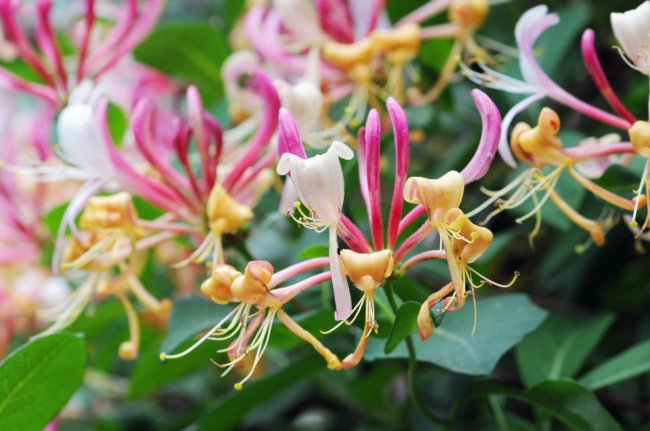
Most of the 180 varieties of deciduous and evergreen honeysuckle shrubs and vines emit a sweet fragrance. Hummingbirds especially like any native honeysuckle varieties. Honeysuckle can grow in full sun to partial shade and is heat-tolerant, but it will need rich, moist soil; occasional pruning; and some kind of support for those bud-laden tendrils.
Honeysuckle is considered invasive in many regions, but birds and insects flock to the plant’s two-lipped tubular flowers. Gardeners worried about out-of-control vines might be happier with a bushy form of honeysuckle, such as winter honeysuckle (Lonicera fragrantissima).
Blooms: Spring to fall
Colors/Varieties: Red, yellow, pink, purple, and white
USDA Growing Zones: Zones 4 to 10, depending on variety
Mature Size: Vines can grow to 30 feet long.
Special Concerns: Invasiveness; damage to trees and other plants that are overtaken by honeysuckle’s aggressive growth habit.
27. Morning Glory (Ipomoea species)
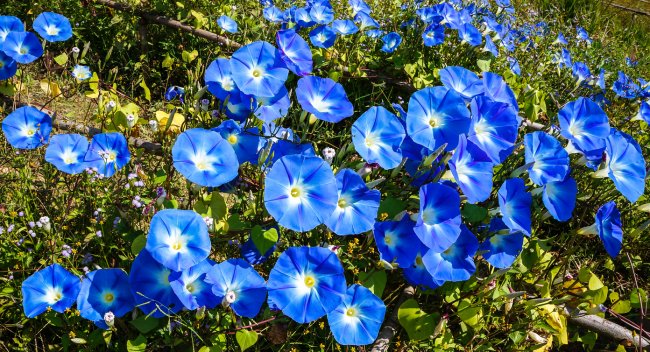
This North and Central American native vine is a fast grower that produces multitudes of slightly fragrant trumpet-shaped flowers that bloom in the morning. They’re drought-tolerant, although morning glories prefer moist, well-draining soil.
Morning glories twine their slender tendrils with heart-shaped leaves around posts, fences, or any available supports, drenching them with flowers. This self-seeder will return—and spread.
Blooms: Summer to first frost
Colors/Varieties: Purple, pink, blue, and white
USDA Growing Zones: Zones 2 to 11
Mature Size: Vines grow to 20 feet long
Special Concerns: Can be invasive.
28. Chaste Tree (Vitex agnus-castus)
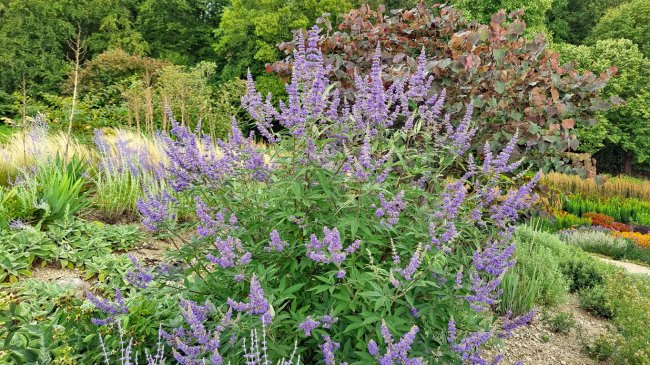
Sometimes planted as a substitute for lilac in regions where lilac won’t grow, chaste tree produces masses of purple blooms that are similar to lilac blossoms. Hummingbirds and other pollinators are attracted to these stunning flower spikes, which can be as long as 18 inches.
Drought-tolerant vitex can be grown as a large shrub or trimmed into tree form. It responds well to pruning, becoming more dense, with an abundance of long, narrow gray-green leaves and beautiful flowers. It can grow in almost any well-draining soil.
Blooms: Spring to fall
Colors/Varieties: Lavender, white, pink
USDA Growing Zones: Zones 6 to 9
Mature Size: 10 to 15 feet tall; 5 to 8 feet wide
Special Concerns: Can rapidly spread.
29. Esperanza (Tecoma stans)
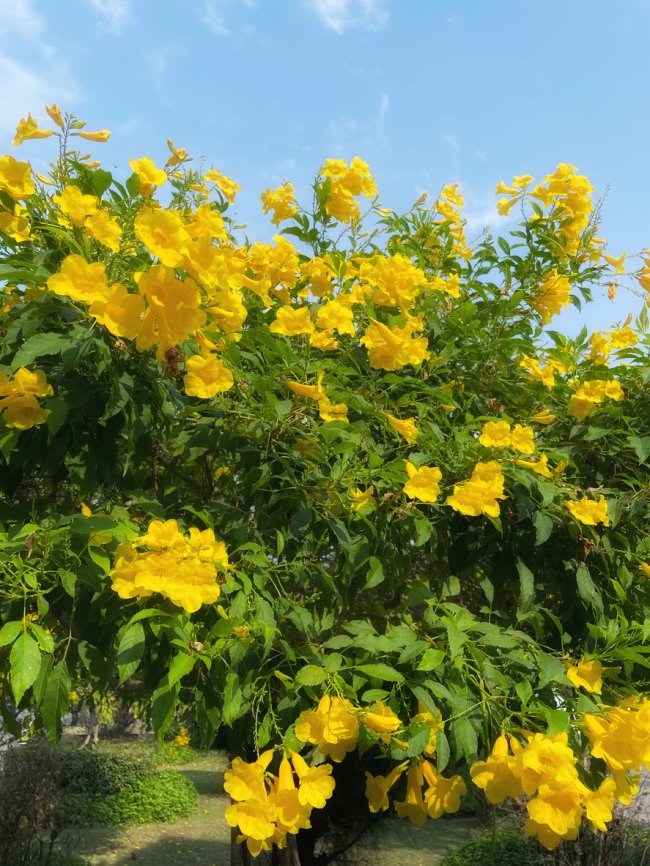
Also called yellow bells or yellow elder, esperanza produces clusters of yellow, bell-shaped flowers that offer tasty nectar to hungry hummingbirds. This plant prefers full sun but will tolerate a bit of afternoon shade.
Gardeners who live where summer temperatures are somewhere in the range of a blast furnace will love that esperanza thrives in the heat. It’s moderately drought-tolerant and not picky about soil as long as it’s well-draining.
Blooms: Spring-fall
Colors/Varieties: Yellow, orange
USDA Growing Zones: Zones 9 to 11
Mature Size: 4 to 5 feet tall and wide, but some cultivars can grow to 20 feet tall.
Special Concerns: It can be invasive.
30. Bird of Paradise (Caesalpinia gilliesii)
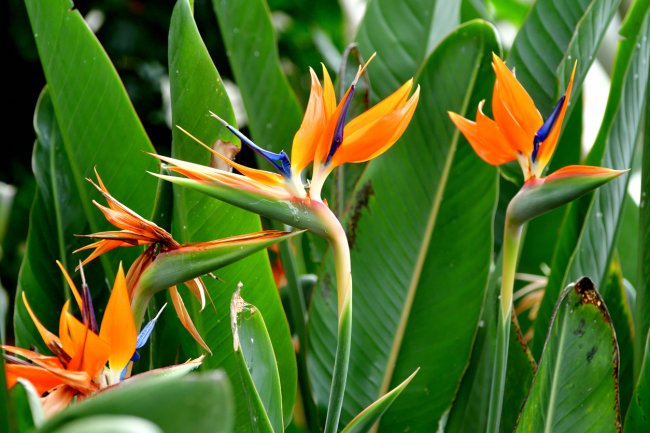
Hummingbirds enjoy sampling the sweet nectar housed in the bird of paradise’s spectacular yellow flowers, which feature dramatically long red stamens. The woody shrub’s blue-green, mimosa-like leaves add to its allure.
Plant this one in full sun, in well-drained soil. This fast-growing showstopper is extremely drought-tolerant. Prune bird of paradise to your preferred shape. It suffers no significant pest problems and is deer-resistant.
Blooms: Spring
Colors/Varieties: Yellow
USDA Growing Zones: Zones 8 to 11
Mature Size: 6 to 10 feet tall; 6 to 10 feet wide
Special Concerns: Seeds and pods are poisonous to humans and animals.
Other Ways to Attract Hummingbirds to Your Garden
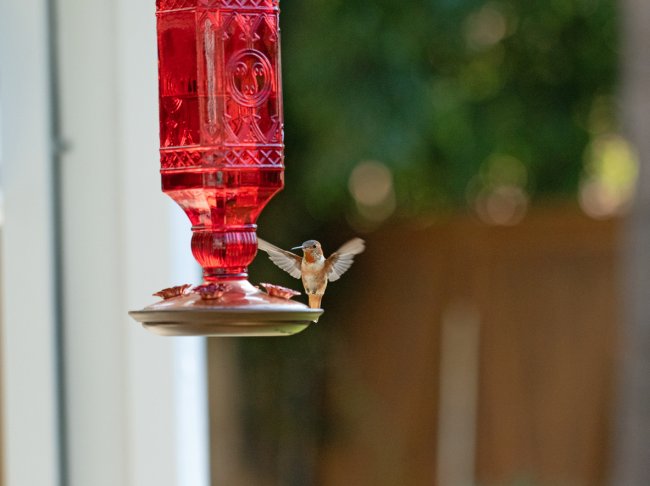
In addition to planting colorful flowers in your yard, there are other ways to attract hummingbirds to your property:
- Provide nesting habitat: Hummingbirds build their tiny nests on the limbs and branches of shrubs and small deciduous trees.
- Encourage insects: Hummingbirds eat insects as well as nectar, so limit use of pesticides to ensure the insect population in your garden is healthy.
- Plan a water feature: Keep a bird bath full and ready to accommodate hummingbirds, which like to bathe often.
- Hang a nectar feeder: Mix 1 cup of water and ¼ cup of white sugar; bring to a boil and stir well. Let the mixture cool and pour it into your hummingbird feeder. If you’re concerned about insects swarming your feeder, learn how to dissuade bees and ants. Ensure a safe environment for the birds by cleaning the hummingbird feeder often. (Don’t have a feeder yet? Consult our tested guide to the best hummingbird feeders for our favorite models.)
